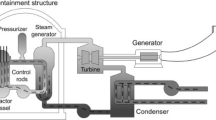Abstract
Nuclear power is a crucial source of clean energy for India. In the near-term, India is focusing on thermal reactors using natural and enriched uranium. In the long-term, India is exploring various options to use its large thorium reserves.
India’s present nuclear installed capacity is 5680 MW, which contributes to about 3.4% of the annual electricity generation. However, nuclear power is an important source of energy in India’s aspirations for energy security and also in achieving its Intended Nationally Determined Contributions (INDC), of 40% fossil free electricity, by 2030. India has limited uranium reserves, but abundant thorium reserves. The Nuclear Suppliers Group (NSG) lifted restrictions on trade with India, in 2008, enabling India to import uranium (natural and enriched) and nuclear reactors. In the near–term (2030), the nuclear capacity could increase to about 42,000 MW. This would be from a combination of domestic Pressurized Heavy Water Reactors (PHWR) and imported Pressurized Water Reactors (PWR). For the long–term (2050), India is exploring various options for utilising its vast thorium reserves. This includes Advanced Heavy Water Reactor and Molten Salt Breeder Reactor. However, generating public acceptance will be crucial to the expansion of the nuclear power program.







Similar content being viewed by others
References
Central Electricity Authority, Government of India: All India Installed Capacity—December 2016 (CEA, 2016). Available at: http://www.cea.nic.in/reports/monthly/installedcapacity/2016/installed_capacity-12.pdf (accessed 31 January 2017).
Ministry of Power, Government of India. Available at: http://powermin.nic.in/en/content/overview (accessed 27 October 2016).
Parliament of India, Lok Sabha: Unstarred Question 1300, answered on November 23, 2016. Available at: http://www.dae.nic.in/writereaddata/ parl/winter2016/lsus1300.pdf (accessed 31 January 2017).
International Energy Agency, IEA: Key World Energy Statistics (2016). Available at: http://www.iea.org/publications/freepublications/ publication/KeyWorld2016.pdf (accessed 31 January 2017).
Planning Commission, Government of India: Final Report of the Expert Group on Low Carbon Strategies for Inclusive Growth (Planning Commission, 2014). Available at: http://planningcommission.nic.in/reports/genrep/rep_carbon2005.pdf (accessed 10 November 2016).
CSTEP: Quality of Life for All: A Sustainable Development Framework for India’s Climate Policy (CSTEP, 2015). Available at: http://cstep.in/uploads/default/files/publications/stuff/CSTEP_Quality_of_Life_for_ All_Report_2015.pdf (accessed 12 November 2016).
Ministry of Environment, Forests and Climate Change, Government of India: India’s Intended Nationally Determined Contribution: Working towards Climate Justice (UNFCCC, 2015). Available at: http://ww4.unfccc.int/submissions/INDC/Published%20Documents/ India/1/INDIA%20INDC%20TO%20UNFCCC.pdf (accessed 29 October 2016).
Parliament of India, Rajya Sabha: Unstarred Question 1711, December 8, 2011. Available at: http://www.dae.nic.in/writereaddata/rsus1711_081211.pdf (accessed on 31 January 2017).
Livemint: PM Narendra Modi Wants Nuclear Power Capacity to be Tripled. Available at: http://www.livemint.com/Politics/ vqSkbdMVwYA2BqybcTmHIK/PM-Narendra-Modi-visits-Bhabha- Atomic-Research-Centre.html (accessed 27 January 2017).
Department of Atomic Energy, Government of India: Three Stages of Indian Nuclear Power Programme. Available at: http://www.dae.nic.in/?q=node/212 (accessed 16 November 2016).
Department of Atomic Energy, Govt of India: Press Release 03/2012 dated April 20, 2012. Available at: http://dae.nic.in/writereaddata/ pr200412_0.pdf (accessed 24 November 2016).
Riyas A. and Mohanakrishnan P.: Studies on physics parameters of metal (U-Pu-Zr) fuelled FBR cores. Science 25, 50–51 (2007).
International Atomic Energy Agency (IAEA): INFCIRC/734-corrected, September 19, 2008. Available at: https://www.iaea.org/sites/default/ files/publications/documents/infcircs/2008/infcirc734c.pdf (accessed January 2017).
Department of Atomic Energy, Government of India: Press Release on Programme of Action for Localisation of Manufacturing in India for Russiandesigned Nuclear Power Plants (Department of Atomic Energy, December 24, 2015). Available at: http://dae.nic.in/writereaddata/moscow24122015.pdf (accessed 26 November 2016).
Grover R.B.: The civil nuclear programme: The last decade and the outlook for the near future. Indian Foreign Aff. J. 10 (3), 255–267 (2015).
Grover R.B.: Opening up of international civil nuclear cooperation with India and related developments. Progress in Nuclear Energy, In Press (September 29, 2016).
IAEA: Power Reactor Information System PRIS. Available at: https://www.iaea.org/PRIS/CountryStatistics/CountryStatisticsLandingPage.aspx (accessed 2 December 2016).
Puthiya Vinayagam P. and Chellapandi P.: Sustainable energy security from fast breeder reactors. Presented at the 6th Nuclear Energy Conclave, Energy Forum, New Delhi, India, 2014. Available at: http://docslide.net/documents/p-puthiya-vinayagam-and-p-chellapandi-indira-gandhi-centrefor- atomic-research-568a65720cb75.html (accessed 6 December 2016).
Puthiyavinayagam P.: Progress in Fast Reactor Programme of India: April 2014-March 2015, 48th Annual Meeting of TWGFR (IAEA at IPPE, Obninsk, May 2015); pp. 25–29.
Umadevi K. and Sreekumar G.: Challenges in reprocessing of high burnup thermal reactor spent fuel. In Proceedings of the first DAE-BRNS symposium on recent advances in nuclear fuel cycle activities (IAEA - INIS, Tarapur, 2015).
Bhabha Atomic Research Centre: AHWR300-LEU: Advanced Heavy Water Reactor with LEU-Th MOX Fuel. Available at: http://dae.nic.in/ writereaddata/.pdf_31 (accessed 5 January 2017).
Banerjee S., Gupta H.P., and Bhardwaj S.A.: Nuclear power from thorium: Different options. Curr. Sci. 111, 1607–1623 (2016). Available at: http://www.currentscience.ac.in/Volumes/111/10/1607.pdf (accessed 25 November 2016).
Wattal P.K.: Recycling challenges of thorium-based fuels in thorium energy for the world. In Proceedings of the ThEC13 Conference, CERN (Globe of Science and Innovation, Geneva, Switzerland, October 27-31, 2013).
Parliament of India, Rajya Sabha: Unstarred Question 1864, (March 3, 2013). Available at: http://www.dae.nic.in/writereaddata/parl/bud2013/ rsus1864.pdf (accessed 29 January 2017).
Parliament of India, Rajya Sabha: Unstarred Question 481, December 3, 2015. Available at: http://www.dae.nic.in/writereaddata/parl/ winter2015/rsus481.pdf (accessed 29 January 2017).
Parliament of India, Lok Sabha: Unstarred Question 63, February 24, 2016. Available at: http://www.dae.nic.in/writereaddata/parl/ budget2016/lsus63.pdf (accessed 29 January 2017).
The Indian Express. Available at: http://indianexpress.com/article/india/ india-others/2-new-russian-reactors-for-kudankulam-to-cost-double-mostexpensive- n-plants/ (accessed 11 January 2017).
The Indian Express. Available at: http://indianexpress.com/article/ business/business-others/jaitapur-nuclear-project-renewed-push-amidlingering- concerns/ (accessed 30 January 2017).
Business Standard. Available at: http://www.business-standard.com/ article/economy-policy/we-are-confident-we-can-make-the-jaitapurproject- economically-viable-vakis-ramany-116112500027_1.html (accessed 26 November 2016).
Reuters cited in The Hindu Business Line. Available at: http://www.thehindubusinessline.com/economy/indiauseximbankintalkson89bnnuclearloansnagsremain/article9135103.ece (accessed 26 November 2016).
Author information
Authors and Affiliations
Corresponding author
Rights and permissions
About this article
Cite this article
Bharadwaj, A., Krishnan, L.V. & Rajagopal, S. Nuclear viewpoint in India. MRS Energy & Sustainability 4, 6 (2017). https://doi.org/10.1557/mre.2017.7
Received:
Accepted:
Published:
DOI: https://doi.org/10.1557/mre.2017.7




